Brian Clegg's Blog, page 31
July 15, 2021
Food, obesity and naughty statistics
 We've just had the latest report for the government to ignore on the National Food Strategy. You can see the BBC coverage of it here.
We've just had the latest report for the government to ignore on the National Food Strategy. You can see the BBC coverage of it here. I absolutely agree with finding ways to encourage people to eat healthier food, and I have no particular aversion to taxing sugar and salt in manufactured food. Don't get me wrong. I love the occasional burger and chocolate biscuit and suchlike. But I'm all in favour of keeping the junk in moderation, and clearly a lot of people need help with that.
So it's not a case of disagreeing with the report or its findings. But I do think they have been guilty of misuse of statistics in presenting their results.
I had a look at the review's report (176 pages in the 'evidence' part alone, though it's not quite as scary as it sounds as each page is essentially a slide, often with graphics). The evidence is divided into two main sections: nature and climate, and health. My issue is with something in the health section, though I do note in passing that the nature section isn't always clear about what it's saying - so, for example, page 15 tells us that 'the amount of land under organic production is declining' - my immediate reaction is that this is a good thing, as it means the land is being used more efficiently, but I'm not sure if that's what the report's writers had in mind.
But the naughty bit I'm particularly interested in is page 100, a version of which provides the only data on the BBC News story and which was brought up as a major item in discussion with the report's lead author Henry Dimbleby on the radio this morning. Here's the original from the report:
 Relative price per calorie of different foods (National Food Strategy Independent Review)
Relative price per calorie of different foods (National Food Strategy Independent Review)There's a lot of detail here, but the main takeaway is that healthy veg like broccoli cost around 3 times as much per calorie than junk food. That's fine, apart from their being other healthy veg like lentils which are cheap per calorie and no one mentioned that, but it's the way this statistic was used that's dubious. We were told that this means that eating healthy food cost more than eating junk. But a major point of eating healthily is to eat fewer calories - so it's senseless to make a comparison on cost per calorie. What's important is cost per meal - and a plate of homemade vegetable curry, say, costs a lot less than a plate of junk food.
This is a worthy cause. But using misleading statistics is not the way to support it. In fact, it gives entirely the wrong message, because it suggests to someone on limited income that it's cheaper to live on junk food, which just isn't true - because eating junk food results in eating far more calories.
June 24, 2021
Imagination's misfires
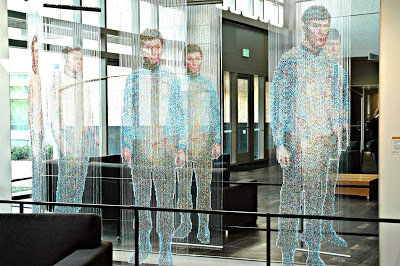 A commonly-held misbelief is that science fiction is about predicting the future. It really isn't. However, this doesn't mean that SF views of the future are not useful in hindsight. They are very good for highlighting the ways in which the imagination misfires.
A commonly-held misbelief is that science fiction is about predicting the future. It really isn't. However, this doesn't mean that SF views of the future are not useful in hindsight. They are very good for highlighting the ways in which the imagination misfires.One of my favourite examples was a James Blish novel, where the author pointed out that electronics would be useless in Jupiter's atmosphere, because the immense pressure would collapse the valves (vacuum tubes) that were required for pre-transistor electronics. But the particular case I would like to use here is more about SF's approach to information. Science fiction from the 1960s and early 70s had a huge miss in envisaging something that is commonplace now - ready access to high bandwidth information flows.
A classic example of this was on the original series of Star Trek, where Mr Spock is regularly seen inserting little plastic rectangular objects into a console to access different data stores. Of course these looked hi-tech when compared with the methods of storing data most of us used back then - but the approach entirely missed the point that it made no sense for data to be stored on little objects you had to manually shuffle when it could simply come from a central store.
Even more dramatic in its fail is a science fiction story I'm currently reading in a collection published in 1970 - SF-17, part of long-running 'New Writings in SF' series edited by John Carnell. In the story More Things in Heaven and Earth by one H. A. Hargreaves, a character decides that they want to listen to some guitar music played by Andres Segovia over breakfast. As I've recently mentioned my music listening is now all streamed, so I was able to do this just now to accompany my writing with a couple of clicks - or have done so by asking Siri. But in the story, the character 'began to absently leaf through the tape listings, then dialled a Segovia'. Shortly after, she 'picked off a cassette as it came through the slot, and slipped it into the console' so now guitar sounds could 'float through the room'. This is in a story set in a university where lectures are given using 3 dimensional holographic video connections, used in interactive lectures across half a continent.
What's fascinating to me is the gap between the imagined future and reality. H. A. overshot on 3D holographic video, but failed to see that the idea of physically transporting information on tapes would not be necessary in a world capable of such data communication.
I'm not saying that science fiction needs to be better at predictions - once again, it's not what it's about. But I do think when we are trying to be imaginative, these misfires reflect assumptions about what can't be changed. We need to be bolder in thinking beyond the way things are done today. All too often imagination is limited by the way things have always been done, or by assumptions about what can and can't be changed.
Next time you are looking for ideas, ask yourself what assumptions you are making, and what could happen differently if those assumptions didn't hold.
June 18, 2021
A farewell to copper
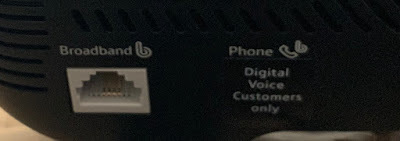 The hidden connector on the routerSome revolutions happen so quietly that many people don't notice - and one such revolution is happening to the telephone system right now.
The hidden connector on the routerSome revolutions happen so quietly that many people don't notice - and one such revolution is happening to the telephone system right now. Our traditional phone system is, frankly, an anachronism. We have a connection to the house designed to bring us voice calls. The internet - frankly our main use of these copper wires now - is clumsily piggybacked onto this antiquated system via the dreaded ADSL filter. But, without any fuss - without, I suspect, most people yet knowing about it - this approach is being phased out.
As of today, the phone sockets in our house no longer work. Instead, the phone is plugged into the back of the broadband router, into a connector hidden behind a sticker. Our 'phone number' is now a dummy thing, with calls arriving across the fibre optic link as Voice over IP and being translated to a fake old phone signal at the box.
 Gone but not missedIt was only a matter of time. The old system was well past its sell-by date. Yet the transfer is not without its issues - both for us and for the phone company.
Gone but not missedIt was only a matter of time. The old system was well past its sell-by date. Yet the transfer is not without its issues - both for us and for the phone company.One thing, of course, is that any hardwired phone handsets around the house will no longer work. We can plug the base of a set of wireless phones (or a single wired phone) into the router, but that's it. As it happens we aren't using any wired handsets, but we did have one on standby in case of a power cut. Traditional phones run on their own power system, so still functioned if the mains power went down. With the new 'Digital Voice service' system, this won't be the case. We are told to use our mobiles instead.
And there's the rub for the phone companies. Like many others, we already use our mobiles for all outgoing calls, only keeping the landline for three households who still use it to call us - plus all those irritating phishing calls. Now's the point when we (and presumably everyone else as they are eventually migrated - BT's timeline is to get everyone over to Digital Voice by 2025) have a big prompt to think 'What's the point of a landline?' and join the increasing number who get rid, or never have one in the first place.
Arguably this isn't really a digital voice service - it's a signal that phone companies are finally taking the step to become solely internet companies and saying goodbye to dedicated voice connections. Like all revolutions there are likely to be some bumps along the way - but I can't say I regret it. It was about time.
A fairwell to copper
 The hidden connector on the routerSome revolutions happen so quietly that many people don't notice - and one such revolution is happening to the telephone system right now.
The hidden connector on the routerSome revolutions happen so quietly that many people don't notice - and one such revolution is happening to the telephone system right now. Our traditional phone system is, frankly, an anachronism. We have a connection to the house designed to bring us voice calls. The internet - frankly our main use of these copper wires now - is clumsily piggybacked onto this antiquated system via the dreaded ADSL filter. But, without any fuss - without, I suspect, most people yet knowing about it - this approach is being phased out.
As of today, the phone sockets in our house no longer work. Instead, the phone is plugged into the back of the broadband router, into a connector hidden behind a sticker. Our 'phone number' is now a dummy thing, with calls arriving across the fibre optic link as Voice over IP and being translated to a fake old phone signal at the box.
 Gone but not missedIt was only a matter of time. The old system was well past its sell-by date. Yet the transfer is not without its issues - both for us and for the phone company.
Gone but not missedIt was only a matter of time. The old system was well past its sell-by date. Yet the transfer is not without its issues - both for us and for the phone company.One thing, of course, is that any hardwired phone handsets around the house will no longer work. We can plug the base of a set of wireless phones (or a single wired phone) into the router, but that's it. As it happens we aren't using any wired handsets, but we did have one on standby in case of a power cut. Traditional phones run on their own power system, so still functioned if the mains power went down. With the new 'Digital Voice service' system, this won't be the case. We are told to use our mobiles instead.
And there's the rub for the phone companies. Like many others, we already use our mobiles for all outgoing calls, only keeping the landline for three households who still use it to call us - plus all those irritating phishing calls. Now's the point when we (and presumably everyone else as they are eventually migrated - BT's timeline is to get everyone over to Digital Voice by 2025) have a big prompt to think 'What's the point of a landline?' and join the increasing number who get rid, or never have one in the first place.
Arguably this isn't really a digital voice service - it's a signal that phone companies are finally taking the step to become solely internet companies and saying goodbye to dedicated voice connections. Like all revolutions there are likely to be some bumps along the way - but I can't say I regret it. It was about time.
June 16, 2021
Listening to music

When I was at university and in my 20s I took listening to music seriously. I had chunky speakers and a big, scary-looking amplifier to wrangle the output of my record deck. As much as possible I listened to music seated appropriately to get a good stereo image.
How things have changed. More often than not (as I write this, for example) I listen to music on reasonable, but not exactly mega speakers attached to my computer. On the move I use AirPods - wireless earbuds - and, again, the sound is fine. And I've now got rid of the final iteration of my home stereo to replace it with what's shown above - a pair of HomePod Minis, each about the same size as my fist. And that's it. No other equipment, no vinyl or CDs cluttering up the place.
Is the sound as good as those chunky speakers and hefty amplifier produced? Well, no. But do I care? Not at all. It's good enough. And in exchange for some loss of audio quality I've got access to the vast majority of recordings that exist as and when I fancy it. I can play a piece of music in several rooms simultaneously when I'm wandering about. I can get suggestions of stuff I've not listened to before which is uncannily clever at being something I'd like, but that stretches my repertoire.
The fact is, I listen to music differently now - so the serious hi-fi was a bit like someone using a Ferrari to do the school run. I'm much happier with the new setup.
June 13, 2021
The Modern Myths - Philip Ball - review
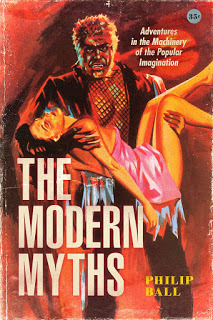 Philip Ball is one of our most esteemed science science writers, so it's easy to think of his new book The Modern Myths as a hobby project. However, Ball brings to this exploration of the idea that stories about the likes of Robinson Crusoe, Dracula, Sherlock Holmes and Batman are our modern day myths the same erudition, attention to detail and careful research as he does to writing about the physical world.
Philip Ball is one of our most esteemed science science writers, so it's easy to think of his new book The Modern Myths as a hobby project. However, Ball brings to this exploration of the idea that stories about the likes of Robinson Crusoe, Dracula, Sherlock Holmes and Batman are our modern day myths the same erudition, attention to detail and careful research as he does to writing about the physical world.Ball's thesis is that there is something about certain stories that enables them to escape the bounds of their origin to mutate and become something quite different - and further reaching - than the original. Often, many of us haven't ever read the originals. And if we have, they can be quite disappointing. As Ball points out, to become a myth, it helps a lot of the original work is ambiguous in interpretation and loosely written. As a result, we are unlikely ever to find 'great literature' taking on mythical form - it is far more likely to come from genre fiction and more recently other media such as graphic novels.
Along the way we discover a lot about the original works and the way that they have inspired a whole range of other versions and stories that have the myth at their heart, even if they have totally different protagonists. If anything, given the importance of malleability and spinning off variants, Ball spends a bit too long on the original and its creator in each case: one thing that seems pretty much impossible to do is to consciously create a myth. It was quite fun when Ball got onto a chapter dedicated to other myths-in-the-making to try to guess what might fit in this class. Before reading on, I guessed the James Bond books, which Ball pleasingly then listed as a possible case.
Inevitably with such a subjective concept, it's unlikely that anyone will agree entirely with Ball's assessment - that's part of the fun of reading a book like this. I found it quite amusing that when talking of Sherlock Holmes, we are told that he and Watson cannot be fixed points in a changing age, as if they were, ‘the works of Conan Doyle would be like those of Dickens or Austen, treasured but immutable.' But, in fact, Jane Austen's work has relatively recently had a fair amount of the treatment Ball uses to identify a myth. Think, for example, of Lost in Austen, Pride and Prejudice and Zombies, Bridgerton and Death Comes to Pemberley.
Arguably, the humour in myth and in the development of myth is the thing that is most missing from this book - Ball's approach is mostly deadly serious (with the exception of the 1960s Batman TV series). This comes through, for example, in his dismissive attitude to Buffy the Vampire Slayer, arguably by far the most innovative development of the Dracula myth, both in the way it subverts the structure and in its brilliant humour - perhaps he hasn't watched it.
Overall, though, this is a wonderful book for anyone interested in the nature of writing and storytelling and the way that we as human beings respond to story and it responds to us. It's a must-have for lovers of myth and genre fiction alike.
The Modern Myths is available from Bookshop.org , Amazon.co.uk and Amazon.com .
Using these links earns us commission at no cost to you
June 9, 2021
Spot the error
Every now and then I get an email from a reader pointing out an error in one of my books. I'm grateful for the opportunity to put things right, even though it's hard not to feel like a parent, having a fault in one of your children pointed out.
The other day, though, I got a correction that felt quite different. The problem was with this illustration from Quantum Computing:
 A reader wrote to me to point out (correctly) that the number in the picture should in fact be 0.7071067811... - obvious, I'm sure you're thinking, but I missed it.
A reader wrote to me to point out (correctly) that the number in the picture should in fact be 0.7071067811... - obvious, I'm sure you're thinking, but I missed it. I couldn't help ask if the reader could do amazing mental arithmetic in his head. It turns out not to be the case. He told me that his job was writing graphics software, and this meant that a few key values come up all the time, one of which happens to be this number.
The number will be fixed in future editions. My thanks to Icon's editorial director, Duncan Heath, for pointing me to this Fry and Laurie sketch, which seemed very appropriate...
March 30, 2021
The unworthy attraction of spurious accuracy
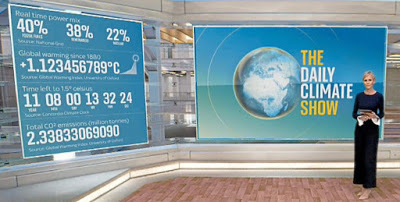 (Photo: Sky UK Limited) I was interested to see a press release announcing that Sky News was to begin broadcasting a daily Climate Show, highlighting the latest information on climate change. It is obviously extremely good that a broadcaster is taking climate change seriously, but it looks as if Sky has fallen for one of the oldest problems in the book when it comes to reporting data: spurious accuracy.
(Photo: Sky UK Limited) I was interested to see a press release announcing that Sky News was to begin broadcasting a daily Climate Show, highlighting the latest information on climate change. It is obviously extremely good that a broadcaster is taking climate change seriously, but it looks as if Sky has fallen for one of the oldest problems in the book when it comes to reporting data: spurious accuracy.I can only guess, but my suspicion is that the show has a bit of a problem with daily reporting on a topic that is changing relatively slowly. There's only so much drama you can put into a slow moving topic, but by making the show daily, Sky would need some impressive graphics, including their huge on-screen display. When I saw this, something leapt out at me. Apparently the average global temperature has gone up by 1.123456789 °C since 1880. Clearly this was just a test number for the display (though it's a shame it appeared in their publicity photo), but equally it seems likely that they intend to display the increase in average temperature to nine decimal places - presumably so it can dramatically tick upwards during the show. But there's a big problem with this.
The good news is, we know where Sky is getting their data - and it is genuinely impressive that they have an attribution for it on their graphic, pointing to the University of Oxford's Global Warming Index. Even so, nine decimal places seems impossibly accurate for a number that is notoriously difficult to calculate. The Earth is a big place and temperatures around the world at the same time can vary hugely, making the deduction of a realistic value really tricky. The Oxford gang do a great job - there's a good paper here describing how it's done. But the interesting thing is to look at the uncertainty in these figures.
In the 2017 paper, Haustein et al tell us that 'the human-induced warming in May 2017, calculated relative to the period 1850–79*, reached +1.01 °C with an uncertainty range of +0.87 to +1.22 °C (5–95% confidence interval).' This tells us that with a reasonable degree of confidence, the rise was somewhere between 0.87 and 1.22 degrees (though it would not be extremely unlikely for it to be outside that range). The value, then is accurate(ish) to about 0.18 degrees either way. This means that the only safe figure is a 1 °C rise. You could probably push this to 1.0 °C. But any further accuracy is pure fantasy.
A value that shows nine decimal places may look pretty on the screen, but it is hugely misleading to the viewer. You wouldn't be impressed if a courier told you that a parcel would arrive at 10.50am, and when it didn't arrive they said 'Oh, that just means it will come sometime this year.' Yet that's far closer than is nine decimal places to one decimal place. Spurious accuracy can result in all kinds of misunderstandings when it is misinterpreted. It can also backfire on the scientists when they have to revise a value. For example, if the temperature rise were calculated more accurately, it might turn out to be, say, 0.9 or 1.2 - this would make it seem like they were stabbing in the dark when they had apparently previously claimed to know it to such accuracy.
So, please Sky News, consider dropping this feature - or if you must make use of this spurious accuracy, please display the confidence intervals on the display too (and explain them). Otherwise the result will not do climate science any service whatsoever.
* So strictly speaking this is not since 1880, but we'll let Sky off on that one.
January 19, 2021
Knit your own coffee (sort-of)
 I have always been very wary of non-coffee substitutes for the real thing, and wouldn't normally think of buying any. However, we get a monthly goody box of odd products that manufacturers are trying to get people aware of, so sell relatively cheaply - the latest including this stuff called Barley Cup. To my surprise, it's not bad. Not great, admittedly, but not bad either.
I have always been very wary of non-coffee substitutes for the real thing, and wouldn't normally think of buying any. However, we get a monthly goody box of odd products that manufacturers are trying to get people aware of, so sell relatively cheaply - the latest including this stuff called Barley Cup. To my surprise, it's not bad. Not great, admittedly, but not bad either.Its main ingredients are barley, rye and chicory. When I saw the C word I was distinctly nervous, having been exposed to the horror that is Camp 'coffee' in my youth. But it only seemed fair to give it a try.
First impressions is it's a kind of anti-coffee. With real coffee, by far the best thing is the smell - the taste is definitely a relative let-down. Here the smell is... well, odd. Certainly not coffee. Not particularly unpleasant - perhaps roasting barley - but not coffee. The taste, however, is not unlike a cheap instant coffee.
As a drink it's warm and wet (as they say), but is never going to thrill. It is no substitute for a pungent, real coffee. But I find too many real coffees upset my stomach, so I tend to drink one or two instant ones a day as well - and this stuff really isn't worse than those, with the advantage that it never had any caffeine in it, rather than being decaffeinated (not always a brilliant process), and also doesn't have all the other slightly dodgy natural chemicals that may well be why coffee upsets my stomach.
One tip if you decide to try it - don't be stingy. You need a good two heaped teaspoons in a mug to get a reasonable outcome. This does mean it's quite expensive compared to instant coffee, with which it's similarly priced by jar size.
January 5, 2021
Review - Rotherweird - Andrew Caldecott *****
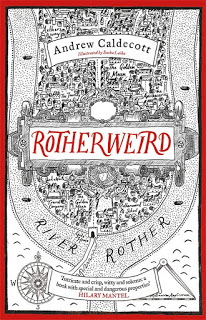 I much prefer fantasy novels set in the real world, rather than some swords and sorcery kingdom, so was delighted to come across Rotherweird, with its cracking concept of an establishment from the sixteenth century that still exists in the present day as a town and surrounding countryside cut off from the rest of England with its own rich traditions. Rotherweird hides a dark secret involving gateways to an alternate world and a phenomenon that can produce strange combinations of creatures and abilities.
I much prefer fantasy novels set in the real world, rather than some swords and sorcery kingdom, so was delighted to come across Rotherweird, with its cracking concept of an establishment from the sixteenth century that still exists in the present day as a town and surrounding countryside cut off from the rest of England with its own rich traditions. Rotherweird hides a dark secret involving gateways to an alternate world and a phenomenon that can produce strange combinations of creatures and abilities.Andrew Caldecott builds particularly, I'd suggest, on the tradition of Mervyn Peake's Gormenghast books, in the gothic complexities and rules of Rotherweird and the odd names, with a touch of Harry Potter thrown in from some aspects of mixing this with modernity. However, the book stands in its own right as a piece of hugely imaginative writing. Some of the characters verge on cliché (to be fair, this is also true of Gormenghast), but there is some interesting development of them, which mitigates this to a degree.
Without doubt, there is a richness and complexity to Rotherweird's world, combined with a well-crafted plot that keeps the pages turning. I think my only issue with the book is the key potential failing of fantasies set in the real world: we can accept any oddity in the fantasy part, but the real world part has to be realistic. Here there are two bumps in the road. Science plays a significant role in Rotherweird (if not the plot), so I wish Caldecott had got some good science advice, as there are a number of issues with the science mentioned in passing. And the idea that a town could be complete cut off from the rest of England by decree in the 21st century probably needed more nuances. In reality there would have been Rotherweird websites, visits by drones and more.
These are small complaints, though. Overall, a great piece of imaginative writing and I am very much looking forward to reading the two (to date) sequels.
Rotherweird is available from Bookshop.org, Amazon.co.uk and Amazon.com.
Using these links earns us commission at no cost to you



